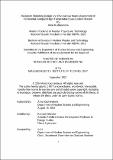Radiation Shielding Design and Radioactive Waste Assessment of Horizontal Compact High Temperature Gas-Cooled Reactor
Author(s)
Kudriavtseva, Anna
DownloadThesis PDF (5.573Mb)
Advisor
Shirvan, Koroush
Terms of use
Metadata
Show full item recordAbstract
With the objective that nuclear power plants utilizing small High Temperature Gas-Cooled Reactors (HTGRs) can provide economic, environmentally favorable and reliable electricity and heat for community and industrial purposes, Boston Atomics LLC initiated the design of Horizontal Compact HTGR (HC-HTGR). This work addresses shielding, activation analysis and the decommissioning cost assessment as an integrated part of the design process.
Reinforced regular and borated concrete were considered as shielding materials for the reactor building and Reactor Cavity Cooling System (RCCS) tanks. It was found that for locations of the reactor building where the dose rates during normal operation were greater than the Nuclear Regulatory Commission (NRC) limit of 0.1 rem/hr, 175 cm of borated concrete is required. The shielding concerns motivated the decision to separate RCCS tanks from the reactor room with a 75 cm borated concrete wall to ensure that the radiation levels do not exceed the NRC limit. Additionally, several shielding options were proposed to protect steam generator modules from radiation-induced activation.
The activation analysis was performed for the key equipment and graphite reflector components of the HC-HTGR design. The core barrel made of Incoloy 800H was characterized as a class C waste component after 40 years of reactor operation. It was proposed that 2.25Cr-1Mo alloy be considered as barrel material to decrease activity levels. The reactor pressure vessel (RPV) and RCCS tubes made of carbon steel were characterized as a class A waste component. The graphite reflector components are characterized as Class C level waste.
Furthermore, this work discusses the neutron irradiation effects and their impact on the integrity of the barrel, RPV, and graphite reflector against material property changes. It was found that 2.25Cr-1Mo alloy has a higher radiation resistance due to the higher iron content in the composition. Based on the results, the reactor vessel is safe from radiation damage for 32 years of operation. The data evaluated for the graphite reflectors indicate that the components should be replaced after 20 years before they pass the turnaround point.
The concentrations of radionuclides computed during activation analysis were used to predict the radiation levels from beta and gamma sources that could be encountered during the disposal of the core barrel and RPV. Based on the obtained data, it is clear that if the barrel is not replaced during operation, the radiation dose rate will remain above acceptable levels, requiring a more rigorous disposal approach. The radiation levels are reduced for the reactor vessel as it was exposed to a lower flux and radiation-induced activation. A similar analysis was performed to derive the exposure dose rate from gamma and beta rays that can be detected by a sensor of a refueling camera. Beta particles will deposit most of the energy in a graphite layer, and the camera will register negligible dose rates. The gamma ray estimates indicate that a more enduring refueling machine is required.
The results of this work provide the disposal costs for HC-HTGR immediate dismantlement and after a given decay period. Overall, the disposal costs of core barrel, RPV and graphite reflector are $13 million for HC-HTGR design after 40 years of full operation if the billable charge limits are set on radioactivity levels. If this option is not considered, the total disposal costs grow up to $225 million. However, extending the storage up to 10 years would decrease the activity, reducing the cost of disposal.
Date issued
2024-09Department
Massachusetts Institute of Technology. Department of Nuclear Science and EngineeringPublisher
Massachusetts Institute of Technology